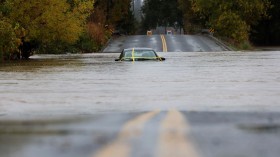Experts believe the early and active fire season was a result of El Niño.
However, the climate crisis turned up the heat and contributed to conditions in the US midwest in which winter temperature records were not just broken but shattered.
Wildfire In US Midwest
The US Midwest often spends the beginning of spring emerging from snow. This year, however, after a mild winter left the landscapes parched, the region was poised to catch fire.
Hundreds of fires have erupted in recent months in states that are used to coping with only a few dozen this time of year, as extraordinary fire behavior defied seasonal patterns.
The midwest, which is defined by the US census as Illinois, Indiana, Iowa, Kansas, Michigan, Minnesota, Missouri, Nebraska, North Dakota, Ohio, South Dakota, and Wisconsin, has a diverse environment that includes grasslands, plains, and woods, but the warmer weather had a widespread impact.
The warm start to the year gave the region a wider window for higher-risk fire conditions, which typically peak in early spring after the snow melts but before trees and grasses "green up."
Vegetation that would ordinarily be concealed by snow berms was exposed to the sun weeks earlier and dried quickly. This triggered unseasonal dry conditions and laid the groundwork for the types of fires that are more difficult to contain.
In Minnesota, the organization in charge of coordinating fire suppression efforts stated that vegetation had dried out "roughly six weeks earlier than normal" and that firefighters in the state had already responded to 50 major fires in early March.
While the fires were largely minor and frequent rather than catastrophic, they contributed to an early increase in burn totals across the country.
More than 1.7 million acres have already burned in the United States, more than tripling the 10-year average for this time of year, according to the National Interagency Fire Center (NIFC).
These numbers were boosted in large part by an explosion of fires in Texas and Oklahoma, including the Smokehouse Creek fire, which burned over a million acres of cattle country and killed tens of thousands of livestock.
The flames in the Midwest, while tiny in comparison, lay siege to landscapes and communities where the resources required to combat large blazes are restricted. The early start of fire season is a disturbing tendency.
"We're not really having fire seasons any more. We're just having fire years," Ben Bohall, public information officer for the Nebraska forest service, said.
Read Also: US Weather Update: Wildfire Threats Southern Plains, North This Weekend
Tougher To Manage
Fires burn differently in the region than those in California or other regions of the west and are often smothered out within the day. But worsening fire conditions have generated burns that are tougher to manage.
The local volunteer firefighters and state departments who battle these blazes can be quickly overwhelmed and may require outside assistance, including aircraft, especially when embers are more difficult to extinguish.
While a spate of storms offered a reprieve in the northern states in recent weeks and the promise of rains returning in the coming months has cooled some of the dangers across the region in the short term, many states in the midwest are still experiencing dry conditions, which could worsen as the weather warms.
According to the most recent federal projections, above-normal temperatures are expected across much of the plains and Mississippi Valley.
As the climate crisis creates increasingly extreme conditions, such as rising temperatures, sharper swings between wet and dry, and a thirsty environment that evaporates moisture more quickly, the conditions that sparked these winter fires may become more common.
"This part of the world is warming and it is warming during the winter time," said Andrew Hoell, a Noaa research meteorologist.
Related Article: Winter Storm Weakens Over Western US, Wildfire Threat from Critical Fire Weather Continue Across High Plains [NWS]
© 2024 NatureWorldNews.com All rights reserved. Do not reproduce without permission.






